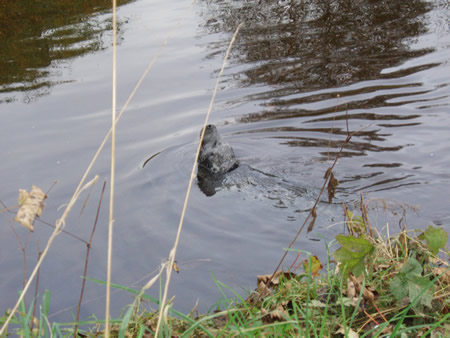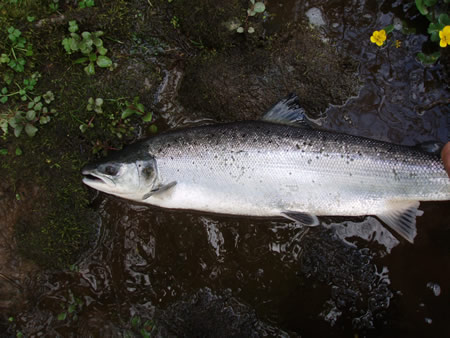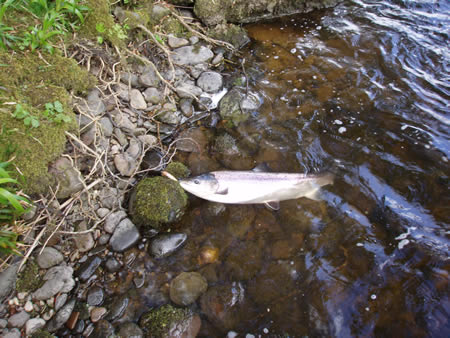These bulletin blogs represent news about Finavon and the South Esk, and my views as a riparian owner. They are not the views of any other organisation, nor are they designed to promote the interests of any individual or organisation other than Finavon Castle Water and factors affecting the fishery. Tony Andrews
These cold nights are not the best conditions for catching sea trout, despite the fact that there are sufficient numbers to keep the fisherman interested. Milton Beat, as is so often the case, has provided the bulk of the catches so far in 2012. At the last count 16 salmon, out of a total FCW catch of 21 salmon for the season, came from Milton Beat, with Tyndals, Willows and Volcano scoring regularly. As I write this blog I can say that there are fresh sea trout in Tyndals, Willows and the Boat Pool, but not very many of them.
Last night I caught two 3lbs sea trout in Willows and had the impression that, had I remained standing in one spot about ten yards up from the big bay at the head of Boat Pool, the fish would have come to me, because they were running last night. But the sky cleared after a cloudy and less cold (not warm by any standards!) start to the evening, so that by midnight it was getting really chilly. There were very few fish moving – I counted 3 – but I did have a number of good strong pulls from sea trout just above the big bay. In warmer temperatures there would have been more fish on the bank because all these fish are newly arrived from the sea and, as such, they snatch at the fly, making it difficult to hook them securely.
Seals and other marine predators.
A number of people have asked me recently about the threats posed by pinnipeds and cetaceans (seals, porpoises, dolphins and killer whales) so I thought I would put some notes I wrote in a letter to one of them into this bulletin.

The photograph above is of a harbour seal (Phoca v. vitulina) in the Boat Pool on Milton Beat at Finavon in October 2007. Presumably this ‘rogue’ seal had followed the autumn run of salmon into the river and just kept going. It traversed the dyke at Kinnaird – no mean feat for a sea mammal with flippers, not feet, and swam upstream in a medium river, through shallows, gradients and pools. I just hope that it didn’t teach too many of its companions to do the same, because that is what these rogues do!
While the SMRU (Sea Mammal Research Unit, St Andrews University) and other scientific experts would not deny that salmon and sea trout form part of the diet of both Atlantic Grey Seals and their smaller cousins, the Common Seal or Harbour Seal, it is also true that both species are pretty catholic in their tastes.
The Common Seal (Phoca vitulina) has a global population of between 5 and 6 million, but its numbers in the Btritish Isles have fallen by half in the last decade. Its distribution is throughout the northern parts of both Pacific and Atlantic Oceans. They are the most widespread of the pinniped family of mammals. They are mostly solitary, but sometimes bask in small groups on rocky islets and peninsulas. They are general list feeders and feed in all parts of the water column, including on the sea bed. Their diet comprises cepalapods, crustaceans and a wide variety of other species.
Animals from different groups have different feeding habitats, and there is evidence that individual (‘rogue seals’: see photo above) ‘teach’ members of their group to exploit specific opportunities. For example, seals which enter river catchments and follow the salmon migration upriver, can pass on their habit to others in the group. In short, the common seal is an opportunistic feeder and includes salmon and sea trout in its diet, at certain times and in certain circumstances. But they also eat cod, various species of flatfish, herring, crabs etc. They are carnivorous, but opportunistic rather than specialised in their feeding habits.
There have been severe declines of the common seal in the UK in the last 20 years (Thompson et al. 2001, Lonergan et al. 2007), mainly due to viral diseases, but also to predation and culling in other parts of their range (e.g. in Canada). In 1988 it is estimated that more than 20,000 common seals in UK inshore waters died as a result of a phocine distemper virus, and in 2002 more than 30,000 (Harkonnen et al. 2006) . It is thought that exposure to human waste and terrestrial animals, including pets, may have made the common seal vulnerable to infection from communicable diseases. It is thought that populations of P.v.vitulina have declined by at least 50% in the last ten years, some of which may also be the result of direct competition with expanding populations of Atlantic Grey Seals (Halichoerus grypus – see below).
Licensed culling of Common seals is permitted to protect fisheries. In the current climate and on the basis of the information above, it is extremely unlikely that licences will be issued to any more than a few ‘hot spots’, and even then on a limited basis.
The common seal can live for up to 35 years.
The Atlantic Grey Seal (Halichoerus grypus) poses a much bigger threat than its smaller (about 20%) and less numerous cousin (P.v.vitulina) to Scottish salmon and sea trout stocks. They also pose a threat to salmon farms by breaking into open sea cages and causing mass escapes of farmed fish.
Current numbers of Grey Seals are thought to be:
World population: c. 300,000
Western (N.American) population: c. 150,000
Baltic Sea: c. 7,500
Eastern Atlantic c. 130,000 – c. 140,000
Like the Common Seal, the Grey Seal is an opportunistic carnivor, whose diet ranges from crustaceans and bottom feeding fish to pelagic fish. They also eat sand eels, herring and skates, as well as octopus and lobsters. Their average daily intake is about 5kgs, although they do not eat every day, and not at all during the breeding season. They also occasionally eat sea birds. They can dive to 30 – 70 metres.
The Killer Whale (Orca), along with certain species of sharks including the Great White, are its main predators. By-catch, entanglement, licensed and illegal culling are the main human threats.
Grey Seals will eat what is available, and there is no doubt that sometimes that will include salmon and sea trout.
The Atlantic Grey Seal may pose a greater threat to salmon and sea trout stocks than the Common Seal for the reasons set out above.
The Grey seal is protected under EU law.
Conclusions.
Both species of seal command public and official support, not to mention a degree of affection, extending to EU and national protected status. It is therefore unlikely that any of the UK governments will introduce draconian culling measures further than the limited fishery protection measures already in place. Successful preventive measures have been taken in estuary locations where concentrations of salmon and sea trout are vulnerable to seal predation. At Kinnaber on the North Esk, for example, electronic seal scarers have been used to some effect.
Other inshore predators (more damaging to salmonids than seals?) The cetaceans – whales, dolphins and porpoises in the family Phocenidae also feed in inshore waters. For example, bottlenose dolphins (Tursiops truncatus) and harbour porpoises (Phocoena phocoena) have often been filmed killing salmon in the Moray Firth. Because these animals are generally less visible than seals, which haul out onto tidal rocks or spits, the extent of their impacts on wild salmon and sea trout stocks is less well known. What can be said is that cetaceans are extremely effective pack hunters. They can swim much faster than seals, and therefore pose a greater threat to salmon and sea trout in open water.
There is a nice dichotomy in that the killer whale (Orinus orca), which is relatively common in Scottish waters, feeds on both salmon and seals! These highly intelligent animals feed in pods of up to 40. Travelling pods tend to feed on sea mammals and birds, while resident pods tend to prefer a fish diet. They are well organised hunters, similar to wolves, and their impact on wild salmon and sea trout stocks is largely unknown.
My view on the impacts of seals on wild salmon and sea trout stocks is summarised by the following points, recognising that there are other threats to salmonids stocks in the coastal zone. While we should acknowledge that there is an undoubted threat to stocks from pinnipeds and cetaceans, we should also understand that the likelihood of changing current restrictions on culling is minimal.
- Under current legislation it is extremely unlikely that culling of either species of seal will be extended in the UK. There may be a case for adjusting the law in certain circumstances, but there is little prospect of changing it.
- We need to concentrate our efforts on conserving stocks of wild salmon and sea trout to actions which have a reasonable chance of success.
- Other threats to migratory salmonids in the coastal zone include power generation and transmission, estuarial pollution, low flows, and barriers preventing access to river catchments
- In the oceanic and open sea zones the impacts of by-catch by pelagic trawlers is still largely unknown, but with our increasing knowledge of migratory routes and timings we will soon be in a strong position to negotiate ‘safe corridors of migration’ for both outward (post smolts) and inward migrations (adult fish)
- Climate change leading to warmer waters around UK shores will bring invasive species further north in greater numbers. Sea bass are highly effective predators and, in large numbers, could decimate outgoing smolt migrations (as striped bass already do in the estuaries of US and Canadian rivers).
- Finally, salmon farming and mixed stocks coastal netting generate unnatural concentrations of salmon trapped in nets or cages. Huge numbers of salmon confined in this way attract seals and other predators, which probably have an adverse impact on wild stocks in the vicinity.
TA June 2012


